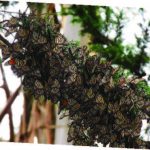Monarch Butterfly
July – August 2013

The lovely sight of the monarch butterfly’s trademark black, white, and orange fluttering wings is becoming more and more rare in Nevada’s skies. According to The Nature Conservancy—an organization involved with monarch research efforts—an explanation for the insect’s disappearance in the West may be due to the elimination of milkweed, an essential source of food for monarch caterpillars as they develop into butterflies.
The River Fork Ranch—a habitat restoration project in the Carson Valley—has been a critical nature research center for more than a decade. The Nature Conservancy purchased the ranch in 2000, with the goal of repairing its wetland, meadow, and riparian habitats along a two-mile stretch of the Carson River.
Milkweed happens to be part of the area’s native plant restoration project, and that’s good news for declining monarch populations (some studies show a 59 percent nationwide decrease), as is the fact that volunteers working with The Nature Conservancy have been studying the insects extensively.
Fundamental to that research is monitoring migratory patterns, which helps biologists understand how they survive in different climates, and why the decline in population is happening here in Nevada. One question on scientists’ minds has been where Nevada monarchs go for the winter. After all, the Carson Valley winters can be harsh even on the humans who call it home.
This past fall, local biologist Pat Neyman tagged and released 64 monarchs, many at River Fork Ranch, in order to observe their migratory patterns. Months later, one of Neyman’s tagged butterflies was photographed in California’s Santa Cruz area, a positive step in the effort to help restore monarch numbers. This work was the catalyst in the River Fork Ranch recently gaining official Monarch Way Station status.



